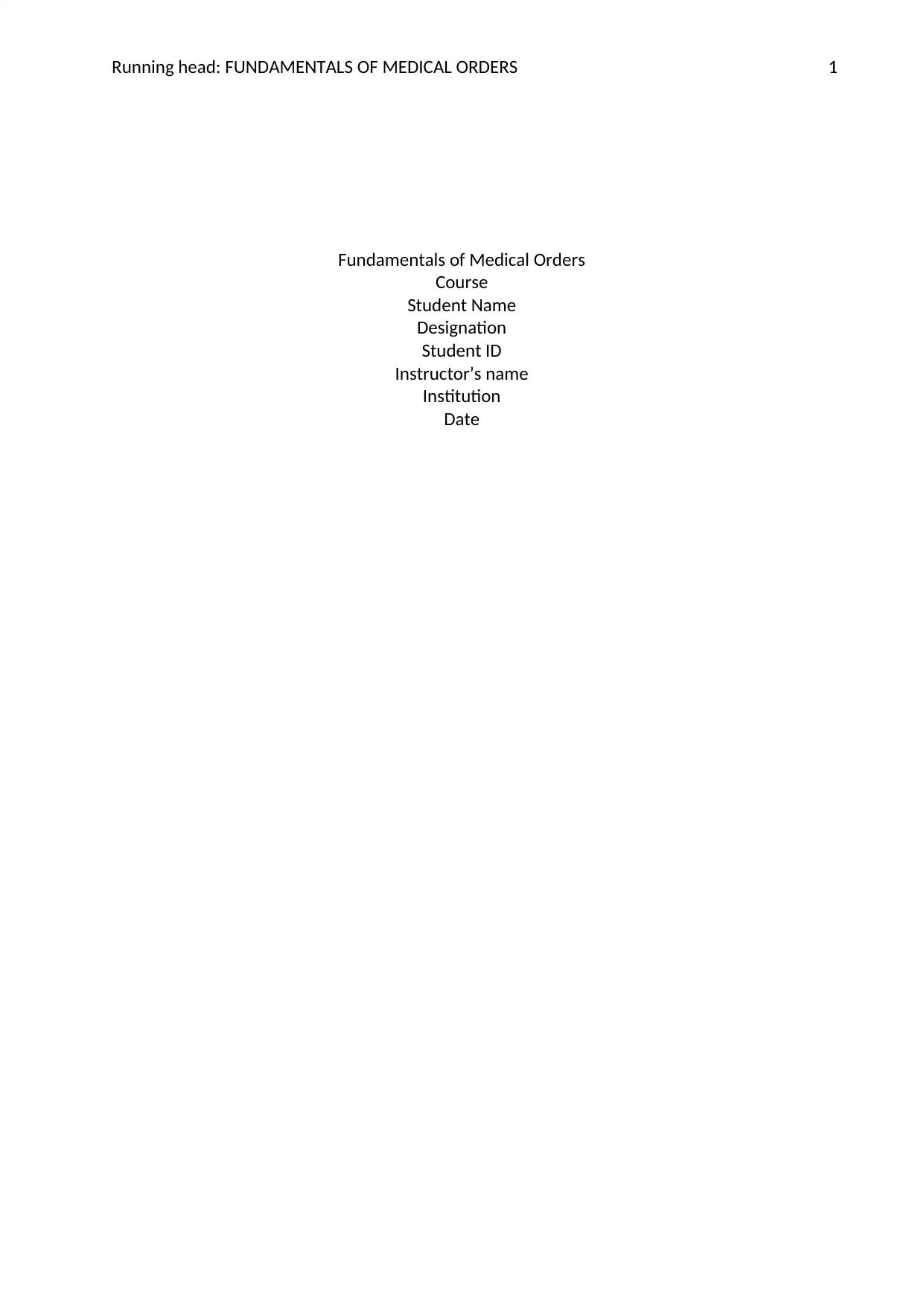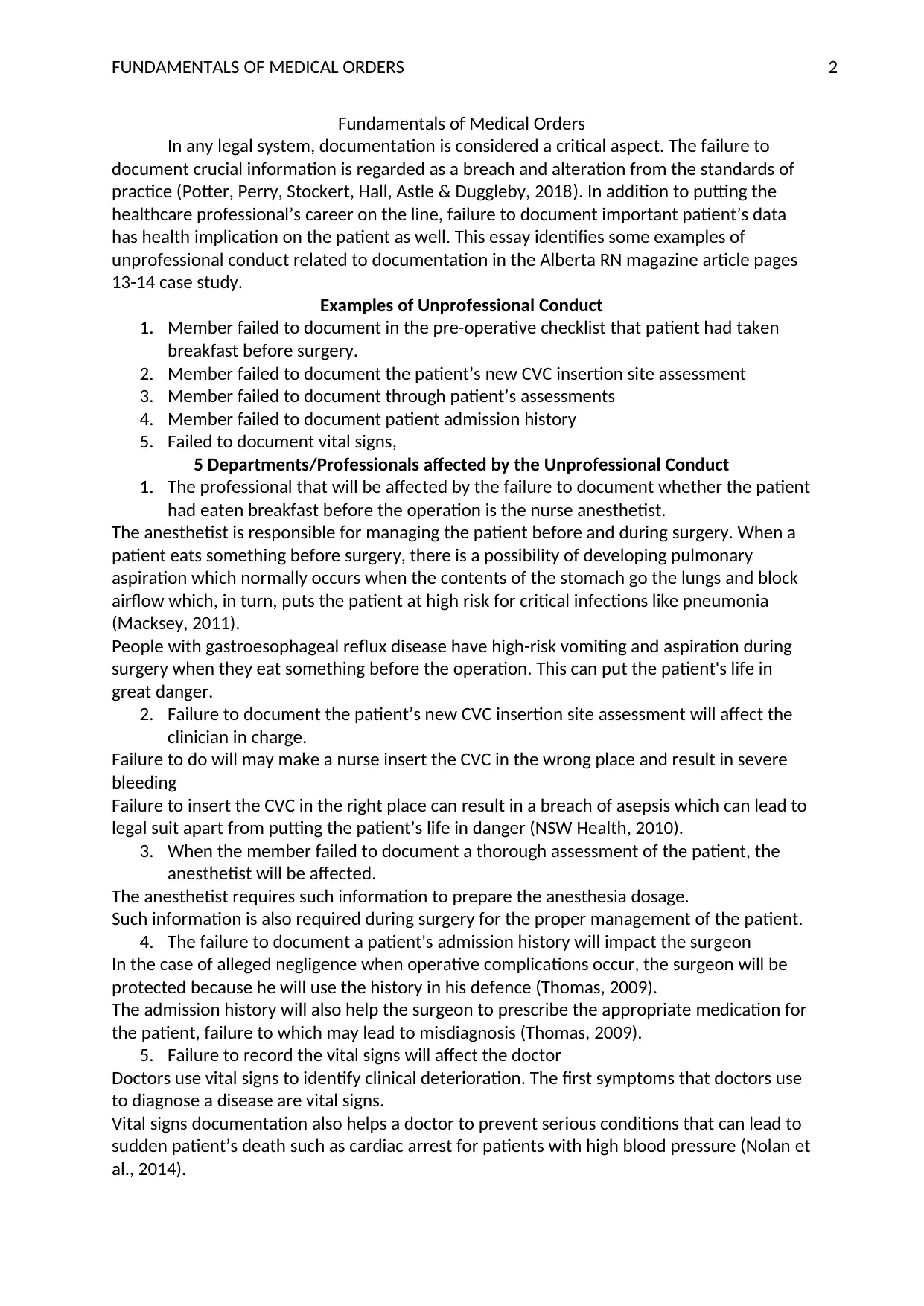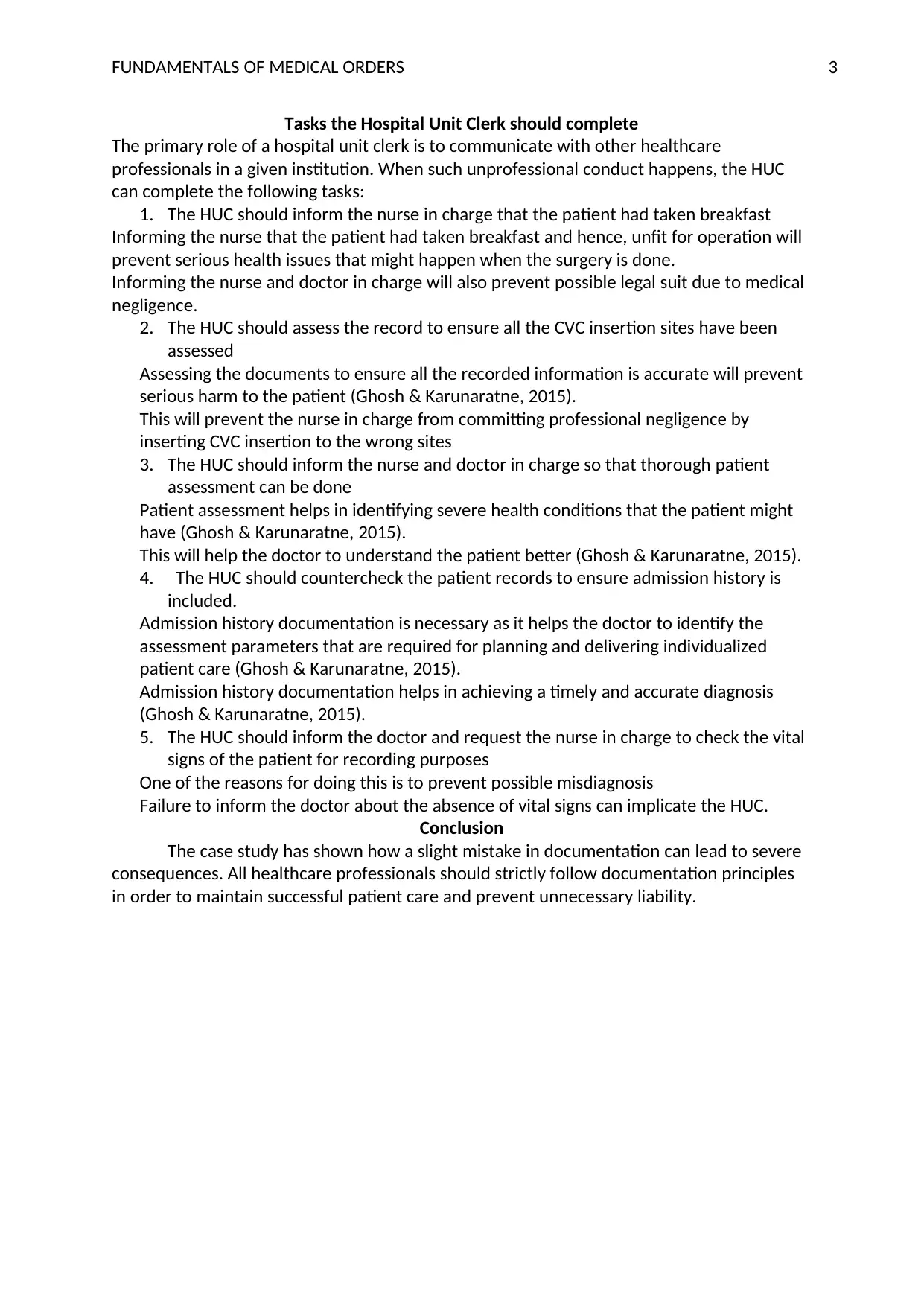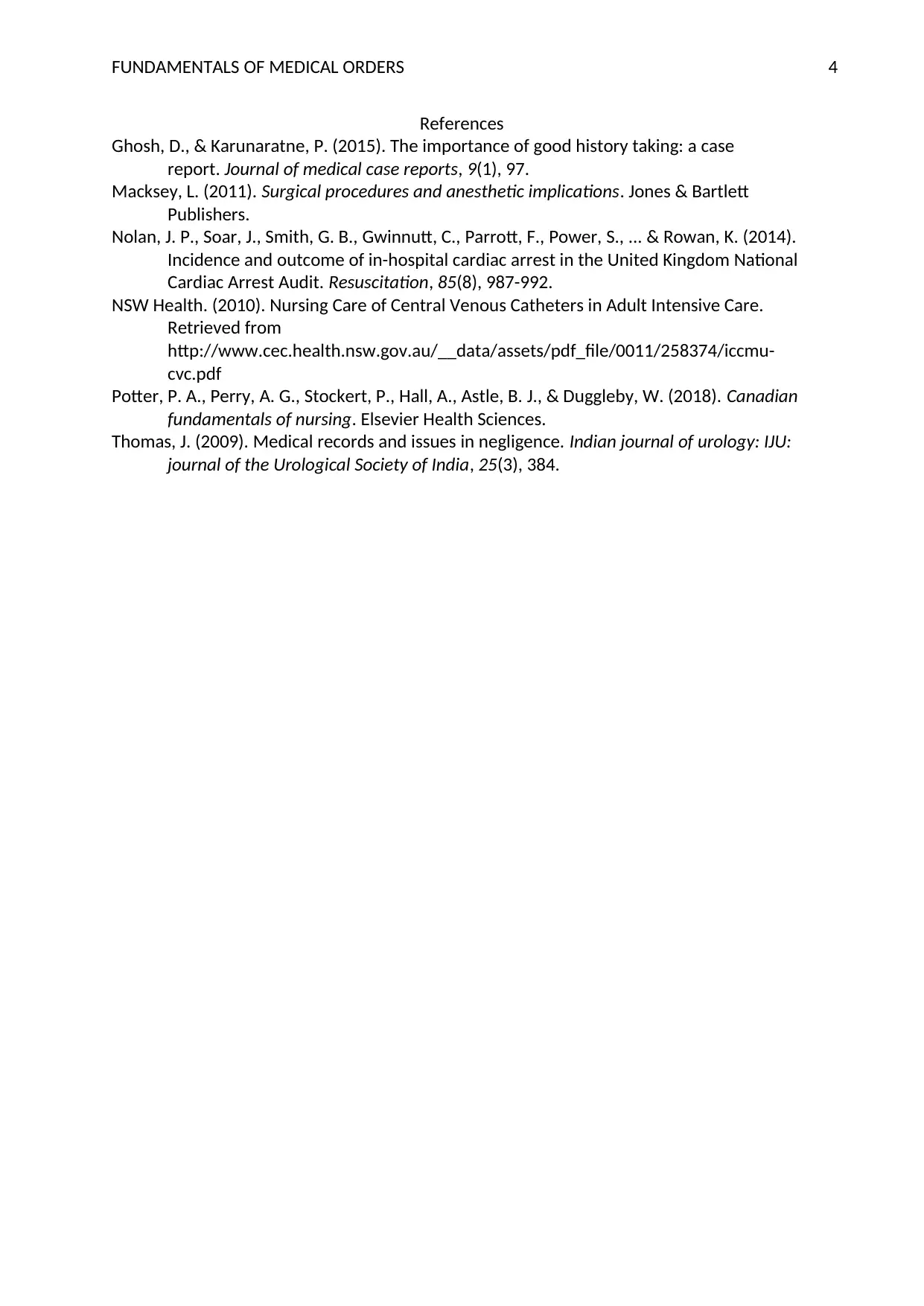Analysis of Unprofessional Conduct in Medical Orders Documentation
VerifiedAdded on 2023/04/26
|4
|1214
|104
Report
AI Summary
This report examines unprofessional conduct in medical orders documentation, focusing on a case study from the Alberta RN magazine. It identifies instances of poor documentation, such as failure to record pre-operative diet, CVC insertion site assessments, patient assessments, admission history, and vital signs. The report details the impact of these documentation failures on various healthcare professionals, including nurse anesthetists, clinicians, surgeons, and doctors, highlighting potential health and legal consequences. Furthermore, it outlines the tasks a Hospital Unit Clerk (HUC) should undertake to mitigate these issues, such as informing relevant parties about missing information and ensuring accurate record-keeping. The report emphasizes the critical importance of adhering to documentation principles to maintain patient care standards and prevent liabilities. The report provides a detailed analysis of the impact of poor documentation in medical orders and offers suggestions on how to improve the documentation process.

Running head: FUNDAMENTALS OF MEDICAL ORDERS 1
Fundamentals of Medical Orders
Course
Student Name
Designation
Student ID
Instructor’s name
Institution
Date
Fundamentals of Medical Orders
Course
Student Name
Designation
Student ID
Instructor’s name
Institution
Date
Paraphrase This Document
Need a fresh take? Get an instant paraphrase of this document with our AI Paraphraser

FUNDAMENTALS OF MEDICAL ORDERS 2
Fundamentals of Medical Orders
In any legal system, documentation is considered a critical aspect. The failure to
document crucial information is regarded as a breach and alteration from the standards of
practice (Potter, Perry, Stockert, Hall, Astle & Duggleby, 2018). In addition to putting the
healthcare professional’s career on the line, failure to document important patient’s data
has health implication on the patient as well. This essay identifies some examples of
unprofessional conduct related to documentation in the Alberta RN magazine article pages
13-14 case study.
Examples of Unprofessional Conduct
1. Member failed to document in the pre-operative checklist that patient had taken
breakfast before surgery.
2. Member failed to document the patient’s new CVC insertion site assessment
3. Member failed to document through patient’s assessments
4. Member failed to document patient admission history
5. Failed to document vital signs,
5 Departments/Professionals affected by the Unprofessional Conduct
1. The professional that will be affected by the failure to document whether the patient
had eaten breakfast before the operation is the nurse anesthetist.
The anesthetist is responsible for managing the patient before and during surgery. When a
patient eats something before surgery, there is a possibility of developing pulmonary
aspiration which normally occurs when the contents of the stomach go the lungs and block
airflow which, in turn, puts the patient at high risk for critical infections like pneumonia
(Macksey, 2011).
People with gastroesophageal reflux disease have high-risk vomiting and aspiration during
surgery when they eat something before the operation. This can put the patient's life in
great danger.
2. Failure to document the patient’s new CVC insertion site assessment will affect the
clinician in charge.
Failure to do will may make a nurse insert the CVC in the wrong place and result in severe
bleeding
Failure to insert the CVC in the right place can result in a breach of asepsis which can lead to
legal suit apart from putting the patient’s life in danger (NSW Health, 2010).
3. When the member failed to document a thorough assessment of the patient, the
anesthetist will be affected.
The anesthetist requires such information to prepare the anesthesia dosage.
Such information is also required during surgery for the proper management of the patient.
4. The failure to document a patient's admission history will impact the surgeon
In the case of alleged negligence when operative complications occur, the surgeon will be
protected because he will use the history in his defence (Thomas, 2009).
The admission history will also help the surgeon to prescribe the appropriate medication for
the patient, failure to which may lead to misdiagnosis (Thomas, 2009).
5. Failure to record the vital signs will affect the doctor
Doctors use vital signs to identify clinical deterioration. The first symptoms that doctors use
to diagnose a disease are vital signs.
Vital signs documentation also helps a doctor to prevent serious conditions that can lead to
sudden patient’s death such as cardiac arrest for patients with high blood pressure (Nolan et
al., 2014).
Fundamentals of Medical Orders
In any legal system, documentation is considered a critical aspect. The failure to
document crucial information is regarded as a breach and alteration from the standards of
practice (Potter, Perry, Stockert, Hall, Astle & Duggleby, 2018). In addition to putting the
healthcare professional’s career on the line, failure to document important patient’s data
has health implication on the patient as well. This essay identifies some examples of
unprofessional conduct related to documentation in the Alberta RN magazine article pages
13-14 case study.
Examples of Unprofessional Conduct
1. Member failed to document in the pre-operative checklist that patient had taken
breakfast before surgery.
2. Member failed to document the patient’s new CVC insertion site assessment
3. Member failed to document through patient’s assessments
4. Member failed to document patient admission history
5. Failed to document vital signs,
5 Departments/Professionals affected by the Unprofessional Conduct
1. The professional that will be affected by the failure to document whether the patient
had eaten breakfast before the operation is the nurse anesthetist.
The anesthetist is responsible for managing the patient before and during surgery. When a
patient eats something before surgery, there is a possibility of developing pulmonary
aspiration which normally occurs when the contents of the stomach go the lungs and block
airflow which, in turn, puts the patient at high risk for critical infections like pneumonia
(Macksey, 2011).
People with gastroesophageal reflux disease have high-risk vomiting and aspiration during
surgery when they eat something before the operation. This can put the patient's life in
great danger.
2. Failure to document the patient’s new CVC insertion site assessment will affect the
clinician in charge.
Failure to do will may make a nurse insert the CVC in the wrong place and result in severe
bleeding
Failure to insert the CVC in the right place can result in a breach of asepsis which can lead to
legal suit apart from putting the patient’s life in danger (NSW Health, 2010).
3. When the member failed to document a thorough assessment of the patient, the
anesthetist will be affected.
The anesthetist requires such information to prepare the anesthesia dosage.
Such information is also required during surgery for the proper management of the patient.
4. The failure to document a patient's admission history will impact the surgeon
In the case of alleged negligence when operative complications occur, the surgeon will be
protected because he will use the history in his defence (Thomas, 2009).
The admission history will also help the surgeon to prescribe the appropriate medication for
the patient, failure to which may lead to misdiagnosis (Thomas, 2009).
5. Failure to record the vital signs will affect the doctor
Doctors use vital signs to identify clinical deterioration. The first symptoms that doctors use
to diagnose a disease are vital signs.
Vital signs documentation also helps a doctor to prevent serious conditions that can lead to
sudden patient’s death such as cardiac arrest for patients with high blood pressure (Nolan et
al., 2014).

FUNDAMENTALS OF MEDICAL ORDERS 3
Tasks the Hospital Unit Clerk should complete
The primary role of a hospital unit clerk is to communicate with other healthcare
professionals in a given institution. When such unprofessional conduct happens, the HUC
can complete the following tasks:
1. The HUC should inform the nurse in charge that the patient had taken breakfast
Informing the nurse that the patient had taken breakfast and hence, unfit for operation will
prevent serious health issues that might happen when the surgery is done.
Informing the nurse and doctor in charge will also prevent possible legal suit due to medical
negligence.
2. The HUC should assess the record to ensure all the CVC insertion sites have been
assessed
Assessing the documents to ensure all the recorded information is accurate will prevent
serious harm to the patient (Ghosh & Karunaratne, 2015).
This will prevent the nurse in charge from committing professional negligence by
inserting CVC insertion to the wrong sites
3. The HUC should inform the nurse and doctor in charge so that thorough patient
assessment can be done
Patient assessment helps in identifying severe health conditions that the patient might
have (Ghosh & Karunaratne, 2015).
This will help the doctor to understand the patient better (Ghosh & Karunaratne, 2015).
4. The HUC should countercheck the patient records to ensure admission history is
included.
Admission history documentation is necessary as it helps the doctor to identify the
assessment parameters that are required for planning and delivering individualized
patient care (Ghosh & Karunaratne, 2015).
Admission history documentation helps in achieving a timely and accurate diagnosis
(Ghosh & Karunaratne, 2015).
5. The HUC should inform the doctor and request the nurse in charge to check the vital
signs of the patient for recording purposes
One of the reasons for doing this is to prevent possible misdiagnosis
Failure to inform the doctor about the absence of vital signs can implicate the HUC.
Conclusion
The case study has shown how a slight mistake in documentation can lead to severe
consequences. All healthcare professionals should strictly follow documentation principles
in order to maintain successful patient care and prevent unnecessary liability.
Tasks the Hospital Unit Clerk should complete
The primary role of a hospital unit clerk is to communicate with other healthcare
professionals in a given institution. When such unprofessional conduct happens, the HUC
can complete the following tasks:
1. The HUC should inform the nurse in charge that the patient had taken breakfast
Informing the nurse that the patient had taken breakfast and hence, unfit for operation will
prevent serious health issues that might happen when the surgery is done.
Informing the nurse and doctor in charge will also prevent possible legal suit due to medical
negligence.
2. The HUC should assess the record to ensure all the CVC insertion sites have been
assessed
Assessing the documents to ensure all the recorded information is accurate will prevent
serious harm to the patient (Ghosh & Karunaratne, 2015).
This will prevent the nurse in charge from committing professional negligence by
inserting CVC insertion to the wrong sites
3. The HUC should inform the nurse and doctor in charge so that thorough patient
assessment can be done
Patient assessment helps in identifying severe health conditions that the patient might
have (Ghosh & Karunaratne, 2015).
This will help the doctor to understand the patient better (Ghosh & Karunaratne, 2015).
4. The HUC should countercheck the patient records to ensure admission history is
included.
Admission history documentation is necessary as it helps the doctor to identify the
assessment parameters that are required for planning and delivering individualized
patient care (Ghosh & Karunaratne, 2015).
Admission history documentation helps in achieving a timely and accurate diagnosis
(Ghosh & Karunaratne, 2015).
5. The HUC should inform the doctor and request the nurse in charge to check the vital
signs of the patient for recording purposes
One of the reasons for doing this is to prevent possible misdiagnosis
Failure to inform the doctor about the absence of vital signs can implicate the HUC.
Conclusion
The case study has shown how a slight mistake in documentation can lead to severe
consequences. All healthcare professionals should strictly follow documentation principles
in order to maintain successful patient care and prevent unnecessary liability.
⊘ This is a preview!⊘
Do you want full access?
Subscribe today to unlock all pages.

Trusted by 1+ million students worldwide

FUNDAMENTALS OF MEDICAL ORDERS 4
References
Ghosh, D., & Karunaratne, P. (2015). The importance of good history taking: a case
report. Journal of medical case reports, 9(1), 97.
Macksey, L. (2011). Surgical procedures and anesthetic implications. Jones & Bartlett
Publishers.
Nolan, J. P., Soar, J., Smith, G. B., Gwinnutt, C., Parrott, F., Power, S., ... & Rowan, K. (2014).
Incidence and outcome of in-hospital cardiac arrest in the United Kingdom National
Cardiac Arrest Audit. Resuscitation, 85(8), 987-992.
NSW Health. (2010). Nursing Care of Central Venous Catheters in Adult Intensive Care.
Retrieved from
http://www.cec.health.nsw.gov.au/__data/assets/pdf_file/0011/258374/iccmu-
cvc.pdf
Potter, P. A., Perry, A. G., Stockert, P., Hall, A., Astle, B. J., & Duggleby, W. (2018). Canadian
fundamentals of nursing. Elsevier Health Sciences.
Thomas, J. (2009). Medical records and issues in negligence. Indian journal of urology: IJU:
journal of the Urological Society of India, 25(3), 384.
References
Ghosh, D., & Karunaratne, P. (2015). The importance of good history taking: a case
report. Journal of medical case reports, 9(1), 97.
Macksey, L. (2011). Surgical procedures and anesthetic implications. Jones & Bartlett
Publishers.
Nolan, J. P., Soar, J., Smith, G. B., Gwinnutt, C., Parrott, F., Power, S., ... & Rowan, K. (2014).
Incidence and outcome of in-hospital cardiac arrest in the United Kingdom National
Cardiac Arrest Audit. Resuscitation, 85(8), 987-992.
NSW Health. (2010). Nursing Care of Central Venous Catheters in Adult Intensive Care.
Retrieved from
http://www.cec.health.nsw.gov.au/__data/assets/pdf_file/0011/258374/iccmu-
cvc.pdf
Potter, P. A., Perry, A. G., Stockert, P., Hall, A., Astle, B. J., & Duggleby, W. (2018). Canadian
fundamentals of nursing. Elsevier Health Sciences.
Thomas, J. (2009). Medical records and issues in negligence. Indian journal of urology: IJU:
journal of the Urological Society of India, 25(3), 384.
1 out of 4
Related Documents
Your All-in-One AI-Powered Toolkit for Academic Success.
+13062052269
info@desklib.com
Available 24*7 on WhatsApp / Email
![[object Object]](/_next/static/media/star-bottom.7253800d.svg)
Unlock your academic potential
© 2024 | Zucol Services PVT LTD | All rights reserved.




